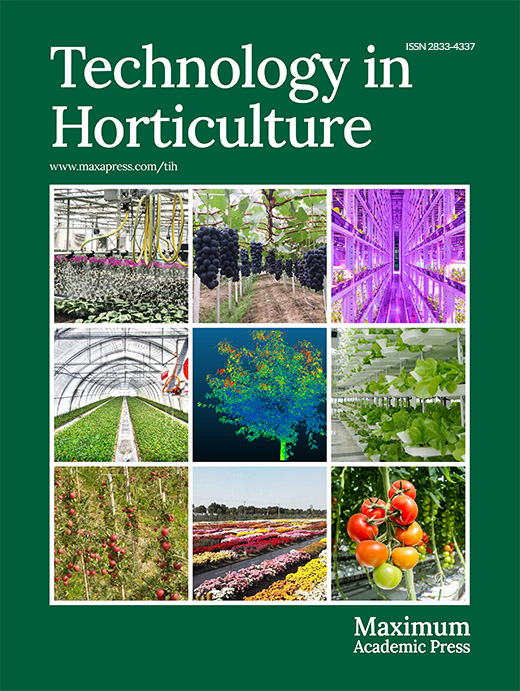-
Potato (Solanum tuberosum L.) is an annual Solanaceae family (nightshade family) crop grown widely for its starchy edible tubers. It ranks fourth in production in the world after wheat (Triticum aestivum), maize (Zea mays), and rice (Oryza sativa). It is cultivated globally at 16.49 million ha with a production of 359.07 million tons, and productivity of 21.76 t·ha−1 [1]. Its primary center of origin and wild relatives are considered in Western South America, while the contemporary landrace gene pools occur from 45° S latitude in Chile to 12° N latitude in Colombia[2]. Potato is an essential crop for food security in Nepal as it ranks as the fourth most important staple food after rice, maize, and wheat. It holds the first position in productivity, second in total production, and fifth in terms of production area[3], with a production of 3.13 million tons and productivity of 16.65 t·ha−1[4], which is far behind the global average of 21.76 t·ha−1[1]. Based on observation and word of mouth, this yield gap could be due to multiple factors, such as poor supply of improved planting material, lack of knowledge among farmers on proper planting depth, spacing, climatic constraints, and irrigation facilities, with improper nutrient management at the top of the list.
Farmers generally use organic manures, compost, or farmyard manure (FYM) as pre-plant fertilizers. Chemical fertilizers like urea, Diammonium Phosphate, and Muriate of Potash (MOP) are recommended for potato cultivation at the rate of 140:220:100 kg·ha−1, pre-plant application[5]. However, applications are not common in mountainous regions due to a lack of fertilizer availability on time and knowledge of nutrient management. Since Nepal still adopts the traditional way of farming, farmers lack knowledge of the appropriate application of fertilizers; as a result, a major portion of nutrients are lost via leaching and surface runoff, causing nutrient deficiency in plants. Potato is a heavy feeder and requires large amounts of nutrients for its growth. It requires 60%−70% of total applied nitrogen (N), and more than half of applied phosphorus (P) and potassium (K) during tuber bulking[6]. Apart from essential macronutrients, some micronutrients are equally vital for optimal potato production as they elevate chlorophyll levels in leaves, improve photosynthesis, increase macronutrient uptake and assimilation, facilitate tuber expansion, and increase yield[7]. Among them, Zn is vital in potato production. It is associated with phosphorus uptake and is responsible for protein and sugar content in tubers; hence, its uptake by plants has been emphasized[8].
The root system of the potato is less developed and shallow, so its ability to absorb nutrients from deeper soil layers is low. Hence, potato plants depend mainly on nutrients available in shallower soil depths. Due to leaching and soil erosion, nutrients get lost from the shallower soil depths, and the plants experience nutrient scarcity. Moreover, the availability of micronutrients applied in the soil is affected by various factors, such as soil pH, soil moisture, soil texture, other elements, and many more[9]. For example, micronutrients like manganese (Mn), iron (Fe), copper (Cu), and zinc (Zn) become less available to plants as the soil pH increases[10]. In the case of foliar application, plants have easy access to micronutrients via leaves which can easily meet their nutrient demand. With foliar application, the leaf epidermis absorbs Zn and efficiently transports it to the developing plant parts through phloem[11]. Unlike soil application, foliar application of Zn ensures easy access to the nutrients for the development of plant foliage, and tuber formation, and enhances the tuber quality[12]. Despite the great potential of ensuring the nutrient supply by foliar application, the nutrient dose is another critical part that still requires extensive research to avoid nutrient toxicity. Educating farmers in advancing agricultural production with better nutrient management is crucial in an agricultural country like Nepal, where potatoes contribute largely to the national economy. This research study aimed to address the problem of low-yield and poor-quality tubers of potatoes in the mountainous region of Nepal. The main objective of this study was to evaluate the effect of foliar application of Zn in different doses on growth, yield, and profitability in potato production in the Dolpa district of Nepal. We hypothesized that the foliar application of Zn will maximize the growth and yield of potatoes, contributing to economic benefits for local farmers in Nepal.
-
A one-year field experiment was conducted in Thulibheri Municipality-3, Dunai, Dolpa, Nepal (28.93° N and 82.89° E), 2,000 m above sea level from 20th of February (planting) to 20th of June 2022 (harvest). The average annual rainfall of the experimental site was 262.3 mm, and the mean annual temperature ranged between 3−10 ºC while the average humidity (RH%) was 60.4%. During the experimental period, a total rainfall of 505.2 mm occurred, with a maximum rainfall of 402.2 mm in June and a minimum rainfall in March of just 0.5 mm precipitation. This exceeds the average annual rainfall in the region by 1.9 times. The average maximum temperature was 22.6 ºC, whereas the average minimum temperature was 10.2 ºC. The maximum and minimum RH% were in February (71.0%) and April (40.2%), respectively[13]. The soil texture was sandy loam (60% sand, 30% silt, and 10% clay) with neutral pH (7.1) at 0−30 cm soil depth, and the soil organic matter content was 3.2%. The total nitrogen, phosphorus, and potassium were 0.2%, 66.0 kg·ha−1, and 436.9 kg·ha−1, respectively. However, the available Zn in the soil was found to be low at only 1.0 ppm.
Experimental design
-
The experiment was laid out in a Randomized Complete Block Design (RCBD) with seven treatments replicated three times, with a total of 21 experimental units. Each experimental plot measured 3.5 m × 2 m (7 m2) and consisted of five rows with eight plants in each row. The row-to-row spacing was 70 cm, while the plant-to-plant spacing was 25 cm. A 0.5-m alley separated each plot. The seven treatments were: control, single foliar spray of Zn-EDTA (Zn-Ethylenediamine tetraacetic acid) at 50 ppm (SS-50), 100 ppm (SS-100), and 150 ppm (SS-150), and double foliar spray of Zn-EDTA at 50 ppm (DS-50), 100 ppm (DS-100), and 150 ppm (DS-150), respectively. This Zn concentration was selected because higher Zn concentrations, 300 and 500 ppm, showed oxidative stress in potato plants and were assumed toxic[14]. For a single spray, Zn was applied once during vegetative growth [60 d after planting (DAP)] and for a double spray, Zn was applied twice, first at the vegetative stage and another at tuber formation (60 and 80 DAP), respectively.
Zinc solution preparation
-
Zn-EDTA (12%) (Shivam Agro Industries, Gujarat, India) was used for the foliar application. A 50-ppm, 150-ppm, and 200-ppm Zn solution was prepared by dissolving 0.5 g, 1 g, and 1.5 g of Zn in 10 L of tap water, respectively. As only 12% Zn was present, 4.17 g, 8.33 g, and 12.50 g of ZnSO4 were used in 10 L of tap water to prepare 50, 100, and 150 ppm of Zn solution, respectively. We selected these treatments based on previous studies conducted in Nepal as well as an understanding of the growers' perception toward micronutrient fertilization. The first foliar spray was done 60 DAP, and the second was done at 80 DAP. The solution was sprayed in the evening to reduce evaporation loss. Horse manure was applied at the rate of 4 t·ha−1, and no other chemicals were used as the experimental site was in an organic province.
Field preparation
-
Field preparation was carried out two weeks before planting and 25 t·ha−1 of horse manure was applied to the field during final tillage. A planting bed was prepared with furrows and ridges, and potato tubers were planted in a row in each furrow of width 35 cm and height 5 cm. Seed tubers of locally popular Cardinal variety, suitable for cold regions, and size 25−50 g were used at the rate of 1.7 t·ha−1. Sprinkle irrigation was done twice a week during the seedling stage, and one irrigation per week was given after canopy development. The irrigation was based on surface observation of soil, the feel method, and local farmers' experience. Earthing up was done after the first Zn spray, 70 DAP. The irrigation was stopped two weeks before harvest for tuber maturation. Harvesting was done at 120 DAP when the plant started yellowing and drying. Dehulling was done a week before harvest.
Data collection
-
Five plants were randomly selected and tagged from each plot. A non-destructive technique was used to record plant height, stem diameter, leaf numbers, and canopy diameter. Plant height was measured from the base of the plant to the topmost point using a measuring scale. For stem diameter, the thickest and thinnest stem portions were measured from each plant using a Vernier caliper to get the average diameter of the plant. The number of leaves per plant was recorded from the sampled plants by manually counting fully open leaves. Using a measuring scale, the plant canopy was measured by taking two longitudinal, diagonal lengths of plant spread atop in NS and EW direction. The data were collected at 75 and 95 DAP. These days were selected for data collection because the research site has a low mean annual temperature, i.e., 3−10 ºC, leading to a longer germination duration. The first foliar spray of Zn was done in 60 DAP, i.e. before the tuber formation stage and data was collected 15 d after the Zn spray. The second Zn spray was done 20 d after the first spray i.e. at the tuber bulking stage in 80 DAP. So, data was again collected 15 d after the treatment application.
Tubers were harvested from a random 1 m2 area (six plants per plot) in each plot for recording yield attributing characters (tuber number, tuber diameter, marketable and non-marketable tubers, and final yield) using a sampling frame. The tuber diameter was measured using the Vernier caliper. The diameter was measured at three different points for larger tubers, and the average diameter was calculated, whereas, for smaller tubers, the diameter was measured at the widest part. Tuber weight was measured using an electronic weighing balance after harvesting from each plant to calculate the plot yield. The tubers were graded into three categories: less than 25 g as undersized tubers, 25−50 g as seed tubers, and greater than 50 g as large-sized tubers[15]. Tuber sizes ranging between 25 and 50 g and above 50 g were categorized as marketable tubers, and tubers less than 25 g were considered non-marketable[16].
Economic analysis
-
The overall cultivation expenses were computed considering the local prices of inputs such as seed tubers, labor, FYM, irrigation, and other essential resources. The total revenue from the yield was determined based on the local price of potatoes. Net profit was obtained by deducting cultivation costs from the total returns. The Benefit-Cost (B:C) ratio was calculated using the formula:
$ \mathrm{B:C\; ratio=(Gross\; return)/(Total\; cost\; of\; cultivation)} $ (1) Statistical analysis
-
All the data were arranged in MS Excel 2019, and data analysis was carried out with R Studio version 4.2.1. Data were checked for normality before analysis of variance. The values presented in the tables are the mean values of each treatment. Analysis of Variance (ANOVA) was conducted and Duncan's Multiple Range Test (DMRT) was performed to determine the difference among treatments at the 5% significance level.
-
Zn significantly influenced plant height at both 75 and 95 DAP (Table 1). At 75 DAP, DS-100, and DS-150 produced taller plants than the rest of the treatments, with an increment in plant height by 37.8% and 41.8%, respectively compared to the control (19.6 cm). At 95 DAP, there was no difference among control, SS-50, and SS-100 in plant height, whereas DS-50, DS-100, and DS-150 increased plant height by 25.65%, 29.25%, and 39.56%, respectively, than control (41.7 cm). This effect may be attributed to zinc's role as a precursor to Indole Acetic Acid (IAA), which is crucial for cell division, elongation, and differentiation[17,18]. For instance, foliar Zn application in tomatoes at 0.25% and 0.5% led to respective increases of 3.7% and 7.3% in plant height compared to the control[19]. Similarly, in an experiment by Ali et al.[20] in summer tomatoes, foliar application of 25 ppm ZnSO4 increased plant height by 8.6%, the number of leaves per plant by 24.6%, and number of branches per plant by 27.0% compared to control. Furthermore, the foliar Zn spray at 300 ppm elevated plant height in potatoes by 5.5% in the first year and 6.2% in the second year. Similarly, the number of leaves per plant increased by 13.5% and 12.9% in the first and second year, respectively, compared to the control[21].
Table 1. Effect of different concentrations of foliar application of Zn-EDTA in potato height, stem diameter, leaf number, and canopy diameter at 75 and 95 DAP in potatoes in Dolpa, Nepal in 2022.
Treatments (ppm) Plant height (cm) Stem diameter (cm) Leaf number Canopy diameter (cm) 75 DAP 95 DAP 75 DAP 95 DAP 75 DAP 95 DAP 75 DAP 95 DAP Control 19.6d# 41.8c 1.2d 1.3d 24.0c 37.0d 36.9c 53.7e SS-50 22.3cd 43.4c 1.2d 1.3d 26.0bc 45.0cd 41.4bc 56.2de SS-100 23.8bc 44.0c 1.3cd 1.4cd 26.0bc 45.0cd 41.4bc 60.1cd SS-150 24.1bc 46.1bc 1.3bc 1.5bc 26.0bc 49.0bc 48.0ab 62.5cd DS-50 24.2bc 52.5ab 1.3bc 1.5ab 30.0ab 55.0ab 50.0a 66.2bc DS-100 27.0ab 54.0a 1.4ab 1.6ab 33.0a 58.0ab 52.3a 69.0ab DS-150 27.8a 58.3a 1.5a 1.6a 34.0a 63.0a 54.2a 72.9a p-value ** ** *** *** ** *** ** *** # Means followed by a different letter(s) within a column are significantly different from each other at p ≤ 0.05. DAP indicates days after planting. *, **, and *** indicate significant results at 5%, 1%, and 0.1% levels of significance respectively. There was a difference among different treatments of Zn concentration on leaf numbers at 75 and 95 DAP (Table 1). At 75 DAP, all three double sprays had more leaf numbers than single spray and control. All three single sprays and control had lower leaf numbers and were statistically similar. The DS-150 and DS-100 had higher leaf numbers by 37.86% and 37.03%, respectively, than the control (24.0). The effect continued to show at 95 DAP with all three double sprays, resulting in a higher leaf count than others. Control, SS-50 and SS-100 ppm had lower leaf numbers than SS-150 ppm and all three double sprays. DS-150 and DS-100 increased leaf number by 69.45% and 55.67%, respectively to control (37.0). This increase in leaf number could be due to the active participation of Zn in chlorophyll formation and growth hormone synthesis[22]. A study showed a significant decrease in chlorophyll content in leaves under no Zn application (186.33 μg gF/W) compared to control (262.07 μg gF/W), indicating the role of Zn in chlorophyll formation and photosynthesis[23]. Additionally, Zn accumulation at nodes after foliar application may stimulate nitrogen metabolism, thus promoting the development of more leaves[24]. Zn is also known to regulate gene expression. Zinc-finger proteins regulate genes involved in the transition of cells from the meristem to differentiated tissues in leaves[25]. Similarly, Zn enhances auxin synthesis, which promotes activation and proliferation of shoot apical meristem cells, leading to increased leaf primordia and subsequently more leaves[26−28]. In research by Eskandari[29], plant height, leaf area index, and stem diameter increased with the highest concentration of Zn application (300 ppm).
Zn concentration significantly affected stem diameter at 75 and 95 DAP (Table 1). At 75 DAP, control and SS-50 produced the lowest stem diameter and were statistically similar. However, DS-150 resulted in a maximum stem diameter followed by DS-100 ppm by 26.7% and 18.3% respectively compared to the control (1.2 cm). Similarly, at 95 DAP, all three double spray treatments had higher stem diameters than the rest of the treatments. Both SS-50 and control had the lowest stem diameter. The DS-150, DS-100, and DS-50 ppm increased stem diameter by 24.80%, 20.93%, and 17.82% compared to the control (1.3 cm). This increase could be attributed to the role of Zn fingers in regulating lignin biosynthesis by recognizing adenine and cytosine elements[30].
Foliar application of Zn at different levels significantly affected canopy diameter at 75 and 95 DAP (Table 1). At 75 DAP, a 46.90% increment in canopy diameter was seen with DS-150 ppm compared to the control (36.9 cm). DS-100 and DS-50 ppm followed the trend with 41.76% and 35.60% increments in canopy diameter, respectively. Control, SS-50, and SS-100 ppm showed lower canopy diameters. The effect continued to 95 DAP, where a double spray of 150 and 100 ppm showed an expansion in canopy diameter by 35.75% and 28.49%, respectively, compared to the control (53.7). Control had the lowest canopy diameter of all. This increase in stem diameter may be attributed to enhanced cell division and nitrogen metabolism due to the presence of Zn in the active lateral meristem[31]. The increase in canopy diameter also showed an ascending trend with elevated concentrations of Zn application. This may be due to the increased plant height and leaf area index following Zn application[32]. Similar findings were observed by Dhakal & Shrestha[12], in which the stem diameter and canopy diameter both increased with increasing Zn concentration (180 ppm double spray). The foliar application of Zn-oxide (ZnO) nanoparticles increased plant height, number of branches, plant biomass, leaf area, and leaf area index compared to untreated potato plants even under drought stress[33]. Moreover, repeated foliar applications of Zn were found to be more effective than single sprays, likely because Zn is not highly mobile within plants. Therefore, multiple applications throughout the season could ensure more consistent availability of Zn[34].
Yield and yield attributes
-
The tuber diameter revealed differences among the different levels of Zn concentration (Table 2). The double spray treatments had higher tuber diameter at harvest than other treatments. The control had the smallest tuber diameter similar to SS-50 and SS-100 ppm. DS-150, DS-100, and DS-50 ppm increased tuber diameter by 27.27%, 26.13%, and 18.18%, respectively, compared to the control (1.1 cm). The increase in tuber diameter with higher Zn doses corresponds to the findings of El-Baky et al.[34], who observed an increasing trend in sweet potato root weight and diameter with increased foliar Zn concentration.
Table 2. Yield and yield attributes of potato as influenced by different concentrations of Zn-EDTA in Dolpa, Nepal in 2022.
Treatments (ppm) Tuber diameter Tuber number per square meter Individual tuber weight (g) Tuber yield (t·ha−1) Control 1.11d# 35.0d 58.1a 19.26c SS-50 1.17cd 40.0c 47.5a 21.19c SS-100 1.20cd 42.7bc 61.6a 22.46bc SS-150 1.26bc 43.3bc 53.6a 23.47bc DS-50 1.34ab 45.0b 48.8a 26.70ab DS-100 1.40ab 49.7a 51.3a 28.09a DS-150 1.44a 51.0a 69.6a 29.99a p-value *** *** NS ** # Means followed by a different letter(s) within a column are significantly different from each other at p ≤ 0.05. DAP indicates days after planting. *, **, and *** indicate significant results at 5%, 1%, and 0.1% levels of significance respectively. NS, not significant. The tuber number per square meter showed a significant response to different levels of Zn concentrations. DS-150 and DS-100 ppm had higher tuber numbers per square meter than other treatments. All three single sprays had a similar number of tubers per square meter. Control had the lowest number of tubers per square meter. DS-150 and DS-100 ppm treatments increased the number of tubers per square meter by 44.47%, and 40.79% respectively than the control (35.0). The increase in tuber numbers with foliar application of Zn can be linked to its role in phytochrome signaling[35], which influences potato tuberization[36,37]. This finding is consistent with Banerjee et al.[38], who reported a higher number of tubers per plant with Zn fertilization, possibly due to increased cytokinin concentration reducing apical dominance and promoting tuber growth[39]. Similar findings were found in the research on strawberries, in which the number of berries increased by 30% with foliar application of 99 mg Zn per liter compared to control[40].
Conversely, there was no significant difference among treatments in terms of individual tuber weight.
There was an increase in tuber yield with an increase in concentration of Zn. The highest tuber yield was obtained with DS-150 followed by DS-100, and DS-50 ppm. All three single sprays had lower tuber yield and were similar to the control treatment. Control and SS-50 ppm had the lowest tuber yield. DS-150, DS-100, and DS-50 ppm increased tuber yield by 55.44%, 45.59%, and 38.34%, respectively compared to the control (19.3 t·ha−1). This can be attributed to the role of Zn in enhancing photosynthesis, carbohydrate metabolism, and photosynthate accumulation. The foliar application of 60 ppm Zn increased the mean weight of potato tuber by 36.4% compared to nutrient-free control[41]. El-Baky et al.[34] discovered similar results in sweet potatoes, where the mean weight of roots increased by 5% compared to the control, with the highest Zn application rate of 30 ppm. The total yield possibly has been increased due to the cumulative effect of improved yield attributes. The foliar application directly supplies Zn to leaf tissues, avoiding soil-related limitations such as leaching loss and element stabilization[42].
Zn aids chlorophyll synthesis, enhancing photosynthesis, and sink accumulation[43]. It also contributes to stress alleviation in plants by regulating hormone biosynthesis, ultimately increasing yield[44]. Besides, Zn-finger transcription factor (BBX21) was found to enhance mesophyll conductance, chloroplast electron transport and reduce abscisic acid (ABA) sensitivity while improving photosynthesis and tuber yield in sub-optimal water availability[45]. Zn finger proteins play a role in gibberellic acid (GA) signaling pathways[46] and the gene StSP6A, which is a part of the gibberellin-regulated network, induces tuber initiation in short days[47]. Moreover, the StZPR1 protein, related to C4-type of zinc finger coordinators, is found to regulate circadian expression patterns of certain genes belonging to B-box zinc finger family like StBBX24[48]. The StBBX24 gene is responsible for flowering and tuberization. For example, potato lines silenced for the StBBX24 gene showed delayed flowering compared to the wild type[49]. Furthermore, auxin, whose synthesis is supported by Zn, has been found to play a crucial role in promoting active starch biosynthesis in the stolon and its deposition as starch granules[50]. It also facilitates the biosynthesis of storage proteins, enhances the influx of assimilates, and boosts the number and size of starch-storing parenchymal cells in the pre-medullary zone[50]. Singh et al.[22,51] found that foliar spray of ZnSO4 (300 ppm) combined with RDF (recommended dose of fertilizer) produced the highest yield of tubers per plot when compared to control and soil application of ZnSO4 alone. In another study by Ahmed et al.[21], the total yield increased by 28% with foliar application of the highest concentration of Zn (300 ppm) in the vegetative stage of potatoes. Foliar application of 100 ppm of ZnO nanoparticles in potatoes (45 and 65 DAP) resulted in the highest total yield and harvest indices compared to 50 ppm ZnO while also significantly reducing water deficit stress in plants[33,52].
Categorical tuber number and weight
-
Zn significantly affected the tuber number based on category (Fig. 1). The tuber below the 25 g category was higher with control, similar to SS-50 and SS-100 ppm. All three doses of double spray showed the lowest tuber number compared to single sprays and control. Control had a 300% higher tuber number than DS-150 ppm (3.0). The tuber size 25−50 g category was higher with DS-100 and DS-150 ppm, similar to DS-50 ppm. Control had the lowest tuber number, with SS-50 and SS-100 ppm being statistically similar to control. DS-150 ppm increased the tuber number by 142% than the control (7.0). Tuber numbers above the 50 g category were highest with DS-100 and DS-150 ppm. Control had the lowest tuber number among all treatments. DS-100 and DS-150 ppm increased the tuber number by 58.9% and 60.6% compared to the control (19.0). There was an overall increase in the tuber number of large-sized categories with an increase in Zn concentration, which can be attributed to the increase in tuber diameter and tuber number with Zn application.
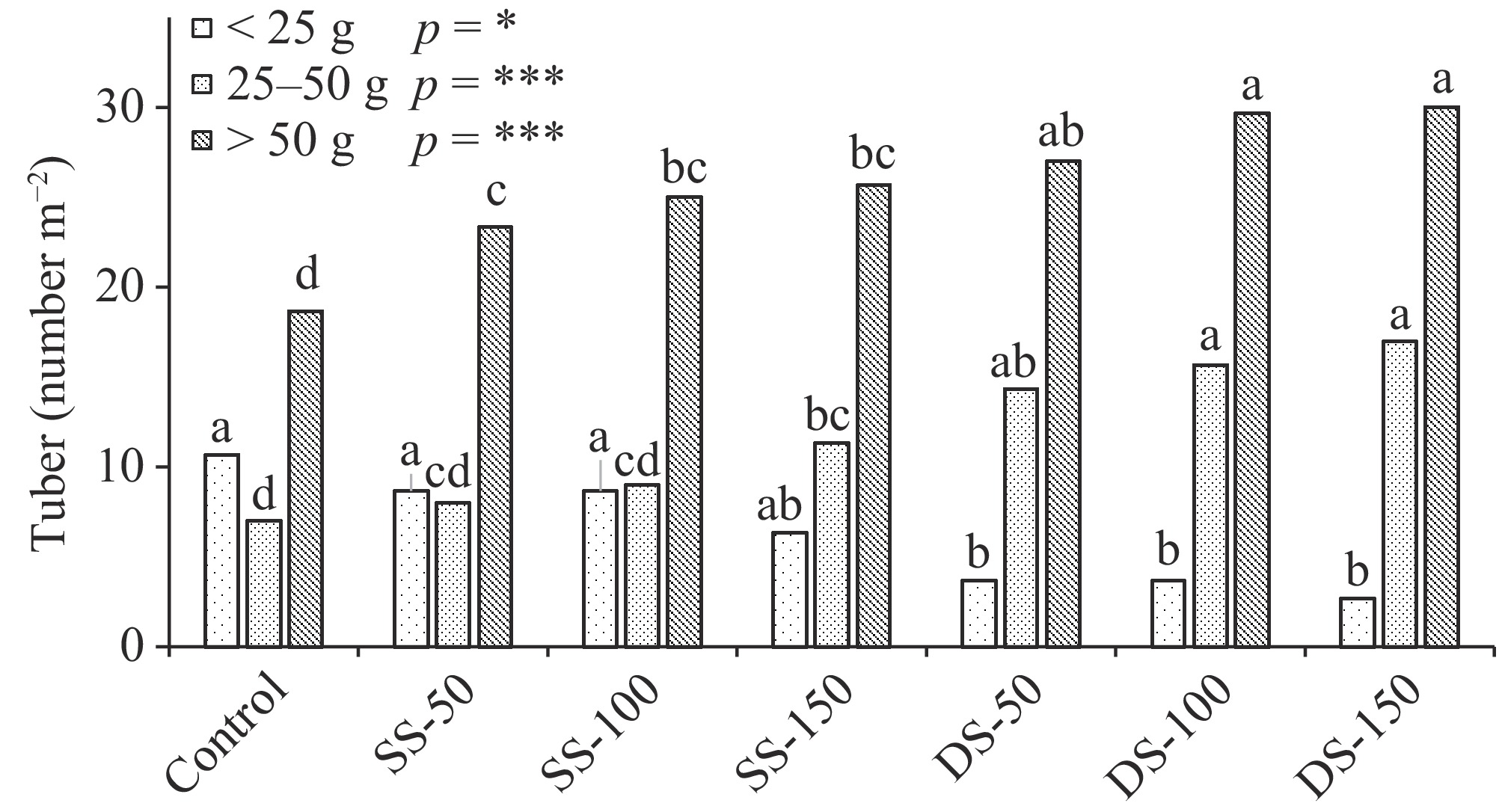
Figure 1.
Categorical tuber number per square meter as influenced by different concentrations of Zn-EDTA at Dunai, Dolpa, Nepal, 2022. Different alphabets in lowercase indicate significant treatment mean difference at p ≤ 0.05. *, ** and *** indicate significant results at 5%, 1% and 0.1% levels of significance respectively.
The tuber weight per square meter was divided into three categories: below 25 g, 25−50 g, and above 50 g. Categorical analysis showed that Zn application influenced tuber weight below 25 g category (Fig. 2). Plots without Zn application had higher tuber weight (82.3 g) in this category followed by SS-50 and SS-100 ppm. The lowest weight was observed with DS-150 ppm (25.7 g). For tubers under 25−50 g, increasing Zn concentration increased tuber weight to a certain extent. The maximum tuber weight was observed with both DS-100 and DS-150 ppm. DS-150 ppm increased tuber weight by 125% compared to zero Zn application (266.7 g). However, results for the above 50 g category showed that maximum tuber weight was found with DS-150 ppm (2,373.3 g) Zn concentration. Control had the lowest tuber weight among all treatments, which was 50% lower than the DS-150 treatment. Overall, Zn concentration increased tuber weight for a larger category than a lower-sized tuber category.
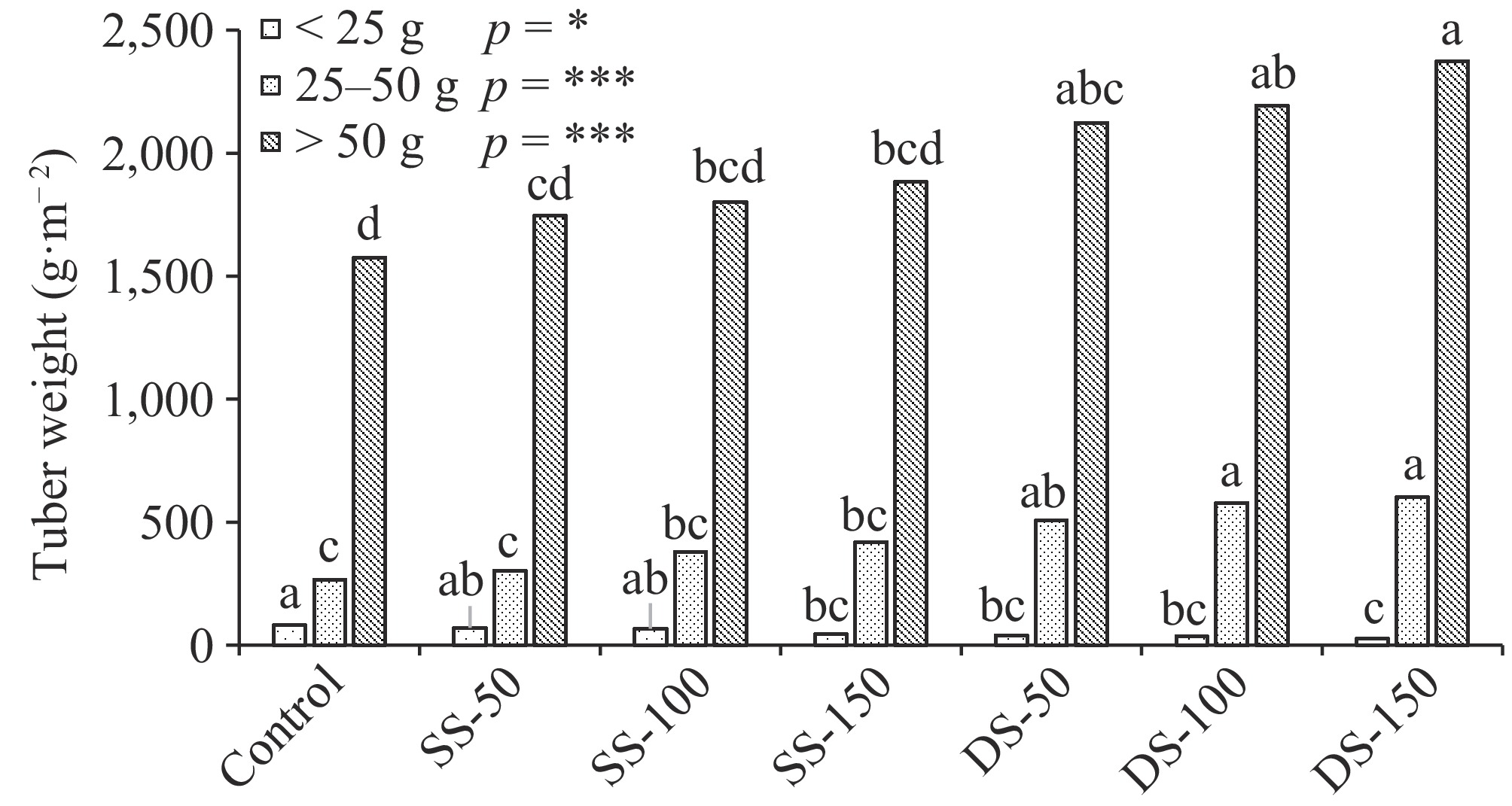
Figure 2.
Categorical tuber weight of potato per square meter as influenced by different concentrations of Zn-EDTA at Dunai, Dolpa, Nepal, 2022. Different alphabets in lowercase indicate significant treatment mean difference at p ≤ 0.05. *, ** and *** indicate significant results at 5%, 1% and 0.1% levels of significance respectively.
Tuber number and weight based on marketability
-
The non-marketable tuber was significantly affected by foliar Zn spray (Fig. 3). Control had higher non-marketable tuber numbers, and single sprays of 50 and 100 ppm were at par with control. Double sprays of 50, 100, and 150 ppm had lower non-marketable tuber numbers than control and all single spray. Control had a 300% higher non-marketable tuber number than double spray 150 ppm (2.67). The marketable tuber number was higher with a double spray of 150 ppm followed by a double spray of 100 ppm and the lowest number was found with control. Double spray of 150 ppm increased the marketable tuber number by 83% compared to control (25.67).
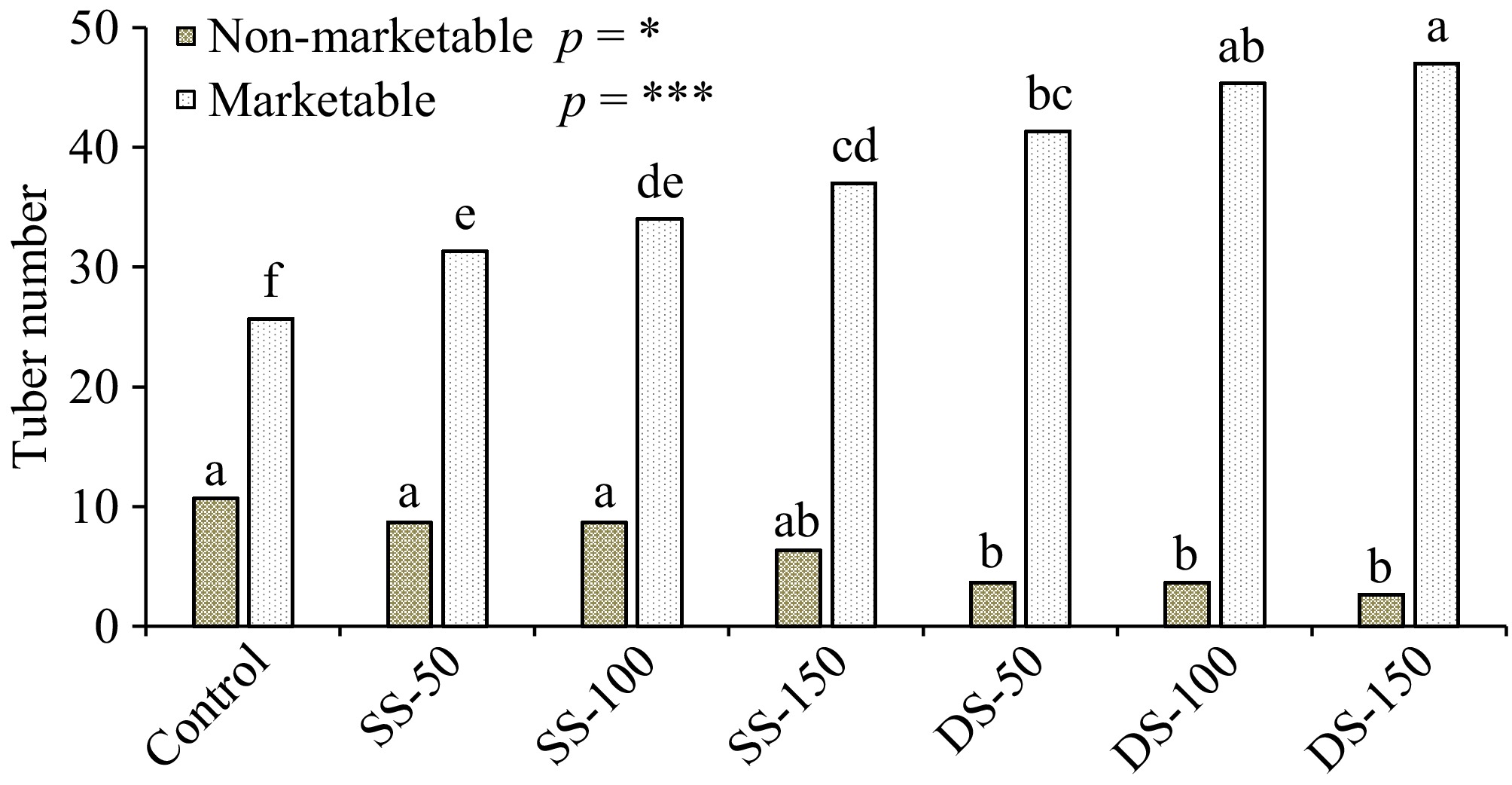
Figure 3.
Total tuber number based on marketability as influenced by different concentrations of Zn-EDTA at Dunai, Dolpa, Nepal, 2022. Different alphabets in lowercase indicate significant treatment mean difference at p ≤ 0.05. *, ** and *** indicate significant results at 5%, 1% and 0.1% levels of significance respectively.
Non-marketable tuber weight was higher with control followed by SS-50 and SS-100 ppm (Fig. 4). However, DS-150 ppm showed the lowest non-marketable tuber weight. DS-150 ppm reduced non-marketable tuber weight by 220% compared to zero Zn application (82.3 g). On the other hand, the marketable tuber weight was higher with DS-150 ppm, which was similar to DS-100 ppm. Control had the lowest marketable tuber weight, which was statistically similar to SS-50 and SS-100 ppm. DS-100 and DS-150 ppm increased marketable tuber weight by 50% and 61% compared to control (1,843.3 g).
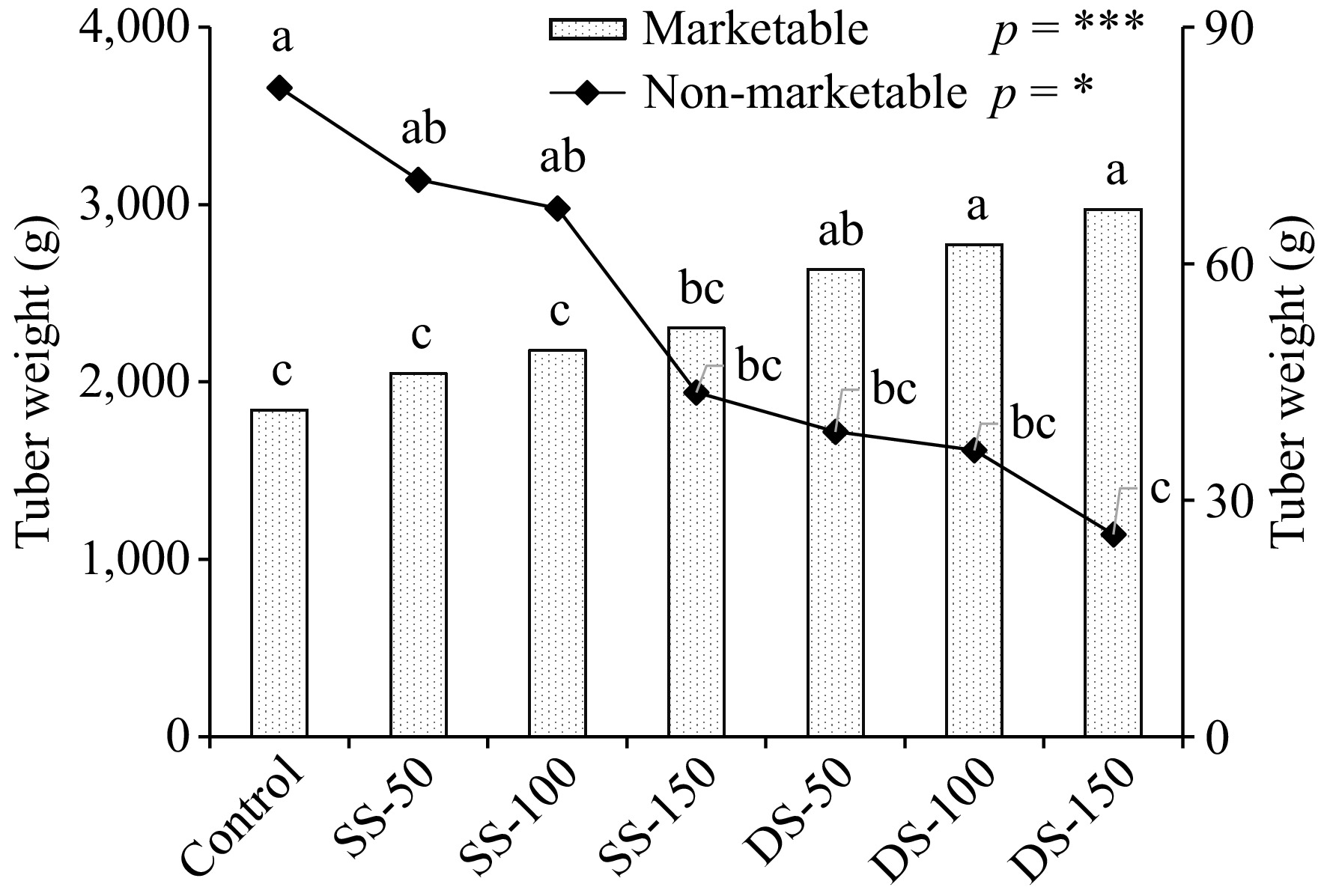
Figure 4.
Total tuber weight based on marketability as influenced by different concentrations of Zn-EDTA at Dunai, Dolpa, Nepal, 2022. Different alphabets in lowercase indicate significant treatment mean difference at p ≤ 0.05. *, ** and *** indicate significant results at 5%, 1% and 0.1% levels of significance respectively.
Marketable and non-marketable tuber weights and tuber numbers were also influenced by the foliar application of various concentrations of Zn, with higher concentrations producing higher marketable tuber weights and marketable tuber numbers. This may be due to the increase in dry matter content of tubers with an increasing Zn application rate[53]. The finding aligns with Ahmed et al.[21], who found an increase in marketable tubers by 2% with increasing Zn concentrations in both seasons.
Economic analysis
-
The cost of cultivation ranged from USD
${\$} $ Table 3. Economic analysis of potato production (USD${\$} $·ha−1) as influenced by different concentrations of Zn-EDTA in Dolpa, Nepal, 2022.
Treatments (ppm) Cost of cultivation (USD${\$} $) Gross income (USD${\$} $) Net income (USD${\$} $) BC ratio Control 1,654.76 7,237.17c# 5,582.40c 3.50c SS-50 1,660.40 7,965.02c 6,304.62c 3.83c SS-100 1,666.04 8,442.32bc 6,776.28bc 4.05bc SS-150 1,671.67 8,819.40bc 7,147.72bc 4.22bc DS-50 1,666.04 1,0034.57ab 8,368.53ab 4.81ab DS-100 1,677.31 1,0556.97a 8,879.66a 5.03a DS-150 1,688.59 11,272.29a 9,583.70a 5.34a p-value ** ** ** # Means followed by different letter(s) within a column are significantly different from each other at p ≤ 0.05. DAP indicates Days after planting. *, **, and *** indicate significant results at 5%, 1%, and 0.1% levels of significance respectively. The foliar application of Zn also influenced the benefit-cost (B:C) ratio (Table 3). The highest B:C ratio was obtained with DS-150 and DS-100 ppm although the B:C ratio was higher in all double spray of Zn treatments compared to single spray and control. This was also due to the substantially high net income compared to the slight increase in the cost of cultivation. For the growers, DS-50 treatment can help to give a comparable B:C ratio with higher double spray doses (DS-100 and DS-150). However, DS-100 and DS-150 increased the B:C ratio by 44% and 53%, and the farmers can get high profitability by selecting any of these two treatments with greater profitability in the later treatment.
-
Foliar application of Zn on potatoes positively impacts overall vegetative growth and yield attributes. The plant height, stem diameter, leaf numbers, and canopy diameter improved significantly with increasing doses of Zn. The increase in Zn concentration consistently increased tuber diameter, number, and weight compared to those without Zn application. The double application of Zn performed better in terms of vegetative growth attributes. In contrast, the yield parameters remained statistically similar with both double and single applications when the final application dose was the same as observed in DS-50 and SS-100 ppm. Based on our findings, double spray of foliar application of Zn is recommended to be economical in terms of tuber production. Our study suggests that DS-50 treatment produced comparable yield and profitability with higher doses of treatments. However, due to the marginal increase in cost for DS-100 and DS-150 and greater yield, income, and profit, potato growers in Nepal are advised to practice double spraying of Zn at higher doses. However, further research is needed to establish the Zn threshold in foliar application to determine the optimum amount for maximum potato production in Dolpa and similar agroclimatic regions.
We would like to express our sincere gratitude to the Agriculture and Forestry University (AFU), Agriculture Development Office (ADO), Dolpa, Nepal, and all the staff for their continuous support and guidance throughout the research period. Financial support for this study was provided by the Prime Minister Agriculture Modernization Project (PMAMP), Government of Nepal, as a fulfillment of the LEE (Learning for Entrepreneurial Experience) requirement for a bachelor's degree.
-
The authors confirm their contributions to the paper as follows: study, conception, and design: Neupane P, Bhatta S; data collection: Neupane P; analysis and interpretation of results: Adhikari M; first draft manuscript preparation: Neupane P, Bhatta S, Adhikari M; manuscript review, editing and revision: Neupane P, Kafle A, Bhatta S. All authors reviewed the results and approved the final version of the manuscript.
-
The datasets generated during and/or analyzed during the current study can be made available on special request to the corresponding author.
-
The authors declare that they have no conflict of interest.
- Copyright: © 2025 by the author(s). Published by Maximum Academic Press, Fayetteville, GA. This article is an open access article distributed under Creative Commons Attribution License (CC BY 4.0), visit https://creativecommons.org/licenses/by/4.0/.
-
About this article
Cite this article
Neupane P, Bhatta S, Kafle A, Adhikari M. 2025. Evaluation of foliar application of zinc at different doses on potato (Solanum tuberosum L.) growth, yield, and economic feasibility in Dolpa of Nepal. Technology in Horticulture 5: e011 doi: 10.48130/tihort-0025-0006
Evaluation of foliar application of zinc at different doses on potato (Solanum tuberosum L.) growth, yield, and economic feasibility in Dolpa of Nepal
- Received: 11 June 2024
- Revised: 23 January 2025
- Accepted: 05 February 2025
- Published online: 19 March 2025
Abstract: Improper nutrient management has limited potato production in Nepal's mountainous region. Farmers prioritize macronutrients but neglect essential micronutrients like zinc (Zn), which are crucial for potato growth and enzymatic functions. However, Zn deficiency is prevalent in these regions and very few studies have highlighted its role in potato production. A field experiment with seven different concentrations of Zn-EDTA was conducted at three different locations with three replications to assess the effect of foliar application of Zn on growth, yield, and economic aspects of potatoes. The treatments were: control, single foliar spray (SS) of Zn at 50, 100, and 150 ppm, and double foliar spray (DS) at 50, 100, and 150 ppm. Results showed that the foliar application of Zn at the highest concentrations (DS-100 and DS-150) increased plant height, leaf number, and canopy diameter. Maximum tuber yield (29.99 t·ha−1), tuber number (51.00), tuber diameter (1.44 cm), and B:C ratio were found with DS-150 ppm followed by DS-100 ppm. The maximum marketable tuber number (47.00) and marketable tuber weight (2,973.67 g) were found with the highest Zn concentration of DS-150 ppm whereas the maximum non-marketable tuber number (10.67) and non-marketable tuber weight (82.33 g) were obtained with control. All DS treatments produced higher yields and B:C ratios. However, DS-100 and DS-150 showed greater profitability due to marginal cost rise and higher income. Therefore, either DS-100 or DS-150 ppm Zn spray can be used. However, further research is needed to establish the threshold levels of Zn foliar application and micronutrient recommendations.
-
Key words:
- Growth /
- Marketable /
- Spray /
- Tuber yield /
- Concentration


